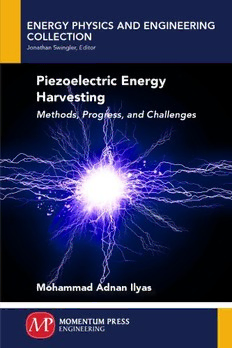
Piezoelectric energy harvesting : methods, progress, and challenges PDF
Preview Piezoelectric energy harvesting : methods, progress, and challenges
EBOOKS Piezoelectric Energy Harvesting ILY A FOR THE S ENERGY PHYSICS AND ENGINEERING Methods, Progress, and Challenges ENGINEERING COLLECTION LIBRARY Mohammad Adnan Ilyas Jonathan Swingler, Editor Create your own Customized Content Environmental pollution has been one of the main c hallenges Bundle — the more for sustainable development. Piezoelectric materials can be used as a means of transforming ambient vibrations into books you buy, Piezoelectric Energy electrical energy to power devices. The focus is on an alter- the higher your native approach to scavenge energy from the environment. discount! Harvesting This book presents harvesting methodologies to evaluate the potential effectiveness of different techniques and provides an THE CONTENT overview of the methods and challenges of harvesting energy Methods, Progress, and Challenges • Manufacturing using piezoelectric materials. Engineering Piezoelectric energy harvesters have many applications, • Mechanical including sensor nodes, wireless communication, microelec- & Chemical Engineering tromechanical systems, handheld devices, and mobile devices. • Materials Science The book also presents a new approach within piezoelectric P ie & Engineering energy harvesting using the impact of raindrops. The energy- zo e le • CEnivviilr &on mental hhaarrvveessttienrg a mndo daenl aprrreasye onft emdu ilst ipfulert hhearr vaensatelyrzse tdo fmora xsiinmgizlee- utnhiet ctric E n e Engineering efficiency of the device. rg y H • Electrical a rv e Engineering Mohammad Adnan Ilyas received a bachelor of engineering stin g (Hon) in electrical and electronic engineering from H eriot-Watt THE TERMS University, UK, in 2012 followed by an MSc in renewable • Perpetual access for energy and distributed generation in 2013. Currently Adnan a one time fee is pursuing his research in energy harvesting with a focus on • No subscriptions or piezoelectrical harvesters to obtain a PhD in electrical engineer- access fees ing at Heriot-Watt University, UK. • Unlimited concurrent usage • Downloadable PDFs • Free MARC records For further information, a free trial, or to order, Mohammad Adnan Ilyas contact: [email protected] ISBN: 978-1-94561-270-1 PIEZOELECTRIC ENERGY HARVESTING PIEZOELECTRIC ENERGY HARVESTING M , P , C ethods rogress and hallenges MOHAMMAD ADNAN ILYAS MOMENTUM PRESS, LLC, NEW YORK Piezoelectric Energy Harvesting: Methods, Progress, and Challenges Copyright © Momentum Press®, LLC, 2018. All rights reserved. No part of this publication may be reproduced, stored in a retrieval system, or transmitted in any form or by any means— electronic, mechanical, photocopy, recording, or any other—except for brief quotations, not to exceed 400 words, without the prior permission of the publisher. First published by Momentum Press®, LLC 222 East 46th Street, New York, NY 10017 www.momentumpress.net ISBN-13: 978-1-94561-270-1 (print) ISBN-13: 978-1-94561-271-8 (e-book) Momentum Press Energy Physics and Engineering Collection Cover and interior design by Exeter Premedia Services Private Ltd., Chennai, India 10 9 8 7 6 5 4 3 2 1 Printed in the United States of America a bstraCt Environmental pollution has been one of the main challenges for sustainable development. Piezoelectric materials can be used as a means of transforming ambient vibrations into electrical energy to power devices. The focus is on an alternative approach to scavenge energy from the envi- ronment. This book presents harvesting methodologies to evaluate the potential effectiveness of different techniques and provides an overview of the methods and challenges of harvesting energy using piezoelectric materials. Piezoelectric energy harvesters have many applications, including sensor nodes, wireless communication, microelectromechanical systems, handheld devices, and mobile devices. The book also presents a new approach within piezoelectric energy harvesting using the impact of rain drops. The energy harvesting model presented is further analyzed for single-unit harvester and an array of multiple harvesters to maximize the efficiency of the device. KEYWORDS autonomous systems, efficiency, Energy harvesting, piezoelectric, PVDF, PZT, raindrop, reliability C ontents List of Figures ix List of Tables xi 1 Introduction 1 2 Energy Harvesting 3 2.1 Context 3 2.2 Autonomous Energy Systems 4 2.3 Vibrational Energy Harvesting 6 2.4 Thermoelectric Energy Harvesting 10 2.5 Photovoltaic Energy Harvesting 13 2.6 Combined Energy Harvesting 14 3 Piezoelectricity 17 3.1 Background Theory 17 3.2 Piezoelectric Materials 18 4 Piezoelectric Energy Harvesting Techniques 23 4.1 Modeling 23 4.2 Mechanical and Electrical Behavior 25 4.3 Circuit Topologies 25 4.4 Experimental Work 26 5 Raindrop Energy Harvesting 31 5.1 Review of Publications 31 5.2 Characteristics of a Harvester 34 5.3 Experimental Investigation 39 viii • COntEntS 6 Conclusion 47 6.1 Challenges 47 6.2 Future Prospects 48 References 49 About the Author 55 Index 57 l f ist of igures Figure 2.1. Block diagram for an autonomous energy harvesting system. 5 Figure 2.2. Model of a vibration energy harvester. 6 Figure 2.3. Circuit diagram of an electromagnetic generator. 7 Figure 2.4. Circuit diagram of an electrostatic generator. 8 Figure 2.5. Circuit diagram of a piezoelectric generator. 10 Figure 2.6. Model adaptation of Seebeck effect. 11 Figure 2.7. Block diagram of a TEG. 12 Figure 2.8. Circuit diagram of a PV cell. 13 Figure 3.1. Structure of piezo crystals. 18 Figure 4.1. Cantilever arrangement with mass. 25 Figure 4.2. Equivalent circuit model for piezoelectric energy harvester. 26 Figure 4.3. Full-wave bridge rectifier. 27 Figure 4.4. Full-bridge rectifier and voltage doubler connected to piezoelectric energy harvester. 27 Figure 4.5. Mass versus output voltage at no load. 28 Figure 4.6. Output power against resistive load. 29 Figure 5.1. Water droplet impact on solid surface. 35 Figure 5.2. Impact zones for water droplets on a piezo device. 39 Figure 5.3. Voltage output and sensor position profiles of the device (Taken from [80]). 40 Figure 5.4. Voltage output of harvester for an impact (Taken from [80]). 40 Figure 5.5. Voltage against load for a single device (Taken from [80]). 41 Figure 5.6. Voltage and power profiles of a single device (Taken from [80]). 42 Figure 5.7. Voltage and peak power the module with multiple devices (Taken from [83]). 43
